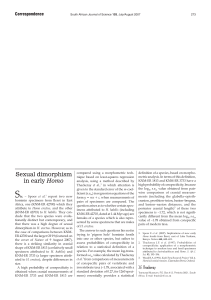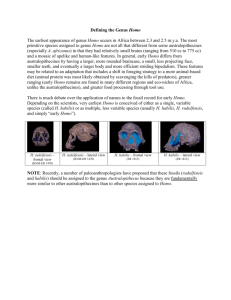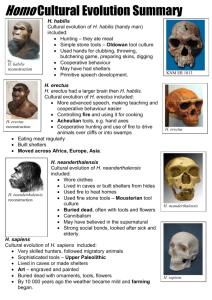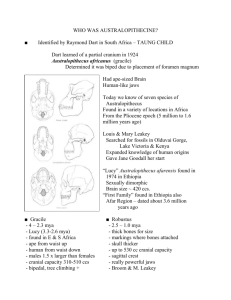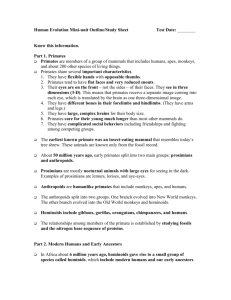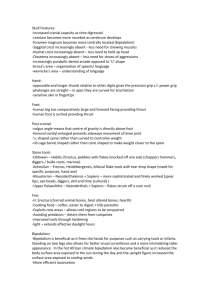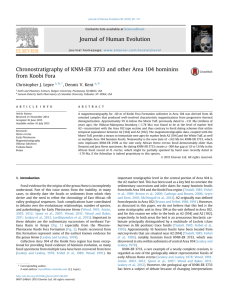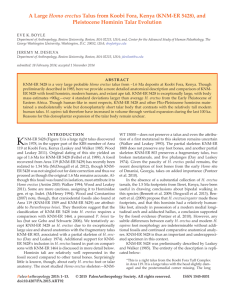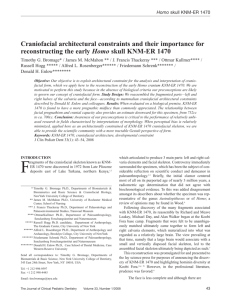letters - Salamander Genome Project
advertisement
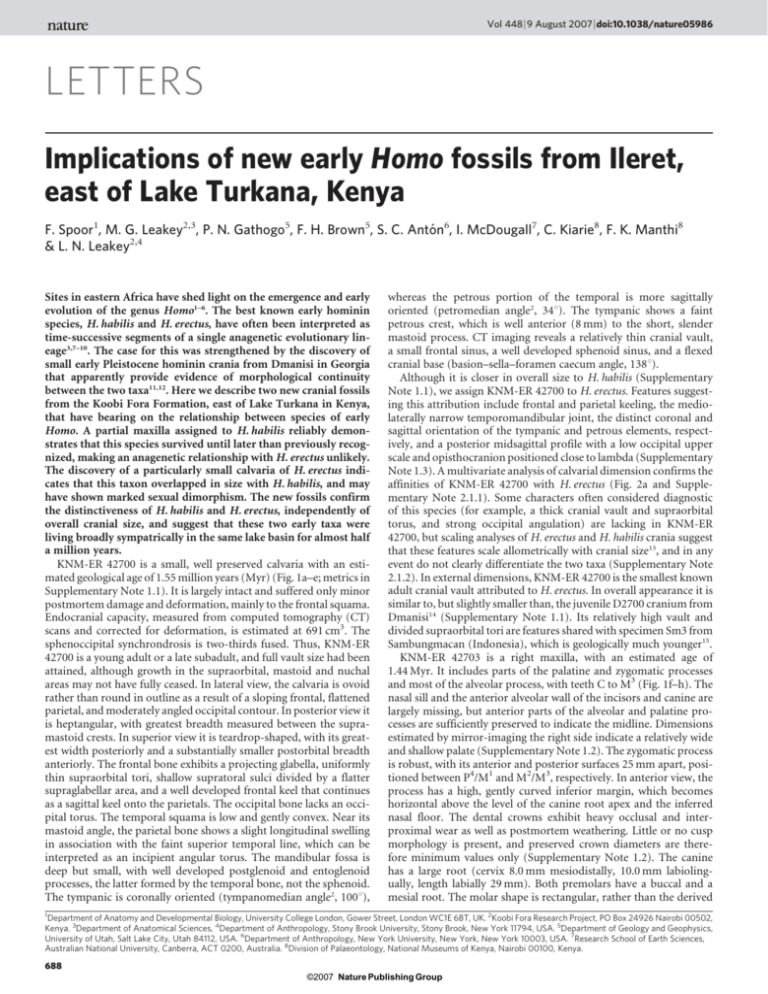
Vol 448 | 9 August 2007 | doi:10.1038/nature05986 LETTERS Implications of new early Homo fossils from Ileret, east of Lake Turkana, Kenya F. Spoor1, M. G. Leakey2,3, P. N. Gathogo5, F. H. Brown5, S. C. Antón6, I. McDougall7, C. Kiarie8, F. K. Manthi8 & L. N. Leakey2,4 Sites in eastern Africa have shed light on the emergence and early evolution of the genus Homo1–6. The best known early hominin species, H. habilis and H. erectus, have often been interpreted as time-successive segments of a single anagenetic evolutionary lineage3,7–10. The case for this was strengthened by the discovery of small early Pleistocene hominin crania from Dmanisi in Georgia that apparently provide evidence of morphological continuity between the two taxa11,12. Here we describe two new cranial fossils from the Koobi Fora Formation, east of Lake Turkana in Kenya, that have bearing on the relationship between species of early Homo. A partial maxilla assigned to H. habilis reliably demonstrates that this species survived until later than previously recognized, making an anagenetic relationship with H. erectus unlikely. The discovery of a particularly small calvaria of H. erectus indicates that this taxon overlapped in size with H. habilis, and may have shown marked sexual dimorphism. The new fossils confirm the distinctiveness of H. habilis and H. erectus, independently of overall cranial size, and suggest that these two early taxa were living broadly sympatrically in the same lake basin for almost half a million years. KNM-ER 42700 is a small, well preserved calvaria with an estimated geological age of 1.55 million years (Myr) (Fig. 1a–e; metrics in Supplementary Note 1.1). It is largely intact and suffered only minor postmortem damage and deformation, mainly to the frontal squama. Endocranial capacity, measured from computed tomography (CT) scans and corrected for deformation, is estimated at 691 cm3. The sphenoccipital synchrondrosis is two-thirds fused. Thus, KNM-ER 42700 is a young adult or a late subadult, and full vault size had been attained, although growth in the supraorbital, mastoid and nuchal areas may not have fully ceased. In lateral view, the calvaria is ovoid rather than round in outline as a result of a sloping frontal, flattened parietal, and moderately angled occipital contour. In posterior view it is heptangular, with greatest breadth measured between the supramastoid crests. In superior view it is teardrop-shaped, with its greatest width posteriorly and a substantially smaller postorbital breadth anteriorly. The frontal bone exhibits a projecting glabella, uniformly thin supraorbital tori, shallow supratoral sulci divided by a flatter supraglabellar area, and a well developed frontal keel that continues as a sagittal keel onto the parietals. The occipital bone lacks an occipital torus. The temporal squama is low and gently convex. Near its mastoid angle, the parietal bone shows a slight longitudinal swelling in association with the faint superior temporal line, which can be interpreted as an incipient angular torus. The mandibular fossa is deep but small, with well developed postglenoid and entoglenoid processes, the latter formed by the temporal bone, not the sphenoid. The tympanic is coronally oriented (tympanomedian angle2, 100u), whereas the petrous portion of the temporal is more sagittally oriented (petromedian angle2, 34u). The tympanic shows a faint petrous crest, which is well anterior (8 mm) to the short, slender mastoid process. CT imaging reveals a relatively thin cranial vault, a small frontal sinus, a well developed sphenoid sinus, and a flexed cranial base (basion–sella–foramen caecum angle, 138u). Although it is closer in overall size to H. habilis (Supplementary Note 1.1), we assign KNM-ER 42700 to H. erectus. Features suggesting this attribution include frontal and parietal keeling, the mediolaterally narrow temporomandibular joint, the distinct coronal and sagittal orientation of the tympanic and petrous elements, respectively, and a posterior midsagittal profile with a low occipital upper scale and opisthocranion positioned close to lambda (Supplementary Note 1.3). A multivariate analysis of calvarial dimension confirms the affinities of KNM-ER 42700 with H. erectus (Fig. 2a and Supplementary Note 2.1.1). Some characters often considered diagnostic of this species (for example, a thick cranial vault and supraorbital torus, and strong occipital angulation) are lacking in KNM-ER 42700, but scaling analyses of H. erectus and H. habilis crania suggest that these features scale allometrically with cranial size13, and in any event do not clearly differentiate the two taxa (Supplementary Note 2.1.2). In external dimensions, KNM-ER 42700 is the smallest known adult cranial vault attributed to H. erectus. In overall appearance it is similar to, but slightly smaller than, the juvenile D2700 cranium from Dmanisi14 (Supplementary Note 1.1). Its relatively high vault and divided supraorbital tori are features shared with specimen Sm3 from Sambungmacan (Indonesia), which is geologically much younger15. KNM-ER 42703 is a right maxilla, with an estimated age of 1.44 Myr. It includes parts of the palatine and zygomatic processes and most of the alveolar process, with teeth C to M3 (Fig. 1f–h). The nasal sill and the anterior alveolar wall of the incisors and canine are largely missing, but anterior parts of the alveolar and palatine processes are sufficiently preserved to indicate the midline. Dimensions estimated by mirror-imaging the right side indicate a relatively wide and shallow palate (Supplementary Note 1.2). The zygomatic process is robust, with its anterior and posterior surfaces 25 mm apart, positioned between P4/M1 and M2/M3, respectively. In anterior view, the process has a high, gently curved inferior margin, which becomes horizontal above the level of the canine root apex and the inferred nasal floor. The dental crowns exhibit heavy occlusal and interproximal wear as well as postmortem weathering. Little or no cusp morphology is present, and preserved crown diameters are therefore minimum values only (Supplementary Note 1.2). The canine has a large root (cervix 8.0 mm mesiodistally, 10.0 mm labiolingually, length labially 29 mm). Both premolars have a buccal and a mesial root. The molar shape is rectangular, rather than the derived 1 Department of Anatomy and Developmental Biology, University College London, Gower Street, London WC1E 6BT, UK. 2Koobi Fora Research Project, PO Box 24926 Nairobi 00502, Kenya. 3Department of Anatomical Sciences, 4Department of Anthropology, Stony Brook University, Stony Brook, New York 11794, USA. 5Department of Geology and Geophysics, University of Utah, Salt Lake City, Utah 84112, USA. 6Department of Anthropology, New York University, New York, New York 10003, USA. 7Research School of Earth Sciences, Australian National University, Canberra, ACT 0200, Australia. 8Division of Palaeontology, National Museums of Kenya, Nairobi 00100, Kenya. 688 ©2007 Nature Publishing Group LETTERS NATURE | Vol 448 | 9 August 2007 a b d e c f g h KNM-ER 42700 (scale bar, 5 cm). f, Anterior, g, occlusal and h, right lateral views of KNM-ER 42703 (scale bar, 2 cm). asymmetrical rhomboidal crown outline seen in some specimens of early Homo and in the M2 and M3 of H. erectus, in particular. A multivariate analysis of maxillary molar dimensions clearly separates H. erectus and H. habilis specimens, with the former having smaller molars overall, as well as a mesiodistally shorter M3 (Fig. 2b, Supplementary Note 2.2). Given this distinction, the affinities of KNM-ER 42703 are with H. habilis, and overall morphology is closest to the larger specimens attributed to this species that are dated to over 1.8 Myr ago (KNM-ER 1805, OH 65)6,16. KNM-ER 42703 and the other H. habilis (sensu stricto) maxillae lack the derived morphology of the H. rudolfensis lectotype KNM-ER 1470, which has anteriorly placed and forwardly sloping zygomatic processes. The small size of KNM-ER 42700 indicates that H. erectus showed substantial size variation throughout the early Pleistocene. Thus, the H. erectus crania from Dmanisi cannot be argued to be primitive, or transitional between H. habilis and H. erectus, on the basis of their small size or of size-dependent characters alone. The intraspecific variation of vault size in H. erectus, including KNM-ER 42700, is larger than in extant humans and chimpanzees, but smaller than in gorillas (Supplementary Note 2.1.3). This degree of variation may well imply that H. erectus showed marked sexual dimorphism, rather than the reduced levels that characterize the derived condition in H. sapiens (contra ref. 17). The presence of supposedly distinctive ‘Asian’ characters18, such as cranial vault keeling and a well separated petrous crest and mastoid process in KNM-ER 42700, underscores the difficulty in separating the African and Asian hypodigms of H. erectus19. This difficulty is further accentuated by the observation that the more angulated occipitals and the thicker vaults and supraorbital tori seen in Asian H. erectus are allometric consequences of an increase in cranial size, rather than independent characters (Supplementary Note 2.1.2). With the discovery of the new, well dated specimens from Ileret, H. habilis and H. erectus can now be shown to have co-occurred in eastern Africa for nearly half a million years. Previously, the most recent occurrence of H. habilis was at 1.65 Myr ago or older (OH 13, Supplementary Note 3)20–22. KNM-ER 42703 now provides a reliable and substantially younger age of 1.44 Myr. The earliest occurrence of specimens with affinities to H. habilis is at approximately 2.33 Myr ago at Hadar (A.L. 666)4, but H. habilis (sensu stricto) first appears in eastern Africa at about 1.9 Myr ago (for example, OH 24)21,23. Diagnostic evidence of H. erectus appears in the African record at about the same time (that is, KNM-ER 2598)2,16, and the youngest African fossils attributed to that taxon are dated to circa 1.0 Myr ago (for example, OH 12, Daka, KNM-OG 45500)19,24,25. Although some characters previously regarded as diagnostic of H. erectus differ from H. habilis simply on the basis of overall cranial size (Supplementary Note 2.1.2), the two taxa are nonetheless b PC 3 a 0.16 +2.5 0.00 0.0 −0.16 PC 3 Figure 1 | The KNM-ER 42700 calvaria and KNM-ER 42703 partial maxilla. a, Anterior, b, left lateral, c, posterior, d, superior and e, inferior views of −2.5 PC 1 −0.25 Africa 0.00 Dmanisi H. rudolfensis Indonesia early H. habilis PC 1 −5.0 0.25 Indonesia late H. affinity habilis 0.00 China KNM-ER 42700 +5.0 Juveniles KNM-ER 42703 Figure 2 | Comparisons of early Homo calvariae and upper molars. Principal component analyses showing plots of principal components (PC) 3 against 1. a, Using ten size-corrected calvarial dimensions. KNM-ER 42700 falls within the convex hull (dashed line) and 95% confidence ellipse of H. erectus, but falls away from the H. habilis and H. rudolfensis specimens. b, Using mesiodistal and buccolingual size of M1 to M3. KNM-ER 42703 falls within the convex hull (dashed line) and 95% confidence ellipse of H. habilis, but falls outside those of H. erectus. Details can be found in Supplementary Notes 2.1.1 and 2.2. 689 ©2007 Nature Publishing Group LETTERS NATURE | Vol 448 | 9 August 2007 Chari Member Lithologic features Channel-form unit v V Chari Tuff Coarsening-upward unit (1.383 ± 0.028 Myr) Fining-upward unit C Clay Silt ʻPink dolomiteʼ ʻMain fish bedʼ Okote Member Lithologic patterns Tuff 42703 (Area 8) C Tuffaceous sand 40 m Conglomeratic mudstone Cross-bedded sandstone Massive sandstone Sandy mudstone v v C 20 m Siltstone C, Fe Claystone C v v v v C C v v Lower Ileret Tuff Symbols (1.527 ± 0.014 Myr) Main Ileret Caliche C, Fe 42700 (Area 1) KBS Member Bioclastic unit/tuff Sand/conglomerate V Tuff v Pumice C Carbonate concretions Fe Iron oxides and hydroxides MnO2 Manganese oxides Mammals Fish C Piscichnus Rhizolith C C, Fe Desiccation cracks v Channel Tuff (Area 8A) C, MnO2 (<1.607 ± 0.019 Myr) Carbonate concretions (caliche) Figure 3 | A composite stratigraphic section of strata in the Ileret area. Components are taken from sections PNG-06A and PNG-08A of ref. 27, adding only the Chari Tuff to section PNG-06A. 40Ar/39Ar ages are from ref. 26. The placement of calvaria KNM-ER 42700 and partial maxilla KNM-ER 42703 are shown. Section in meters (m). metrically and nonmetrically distinguishable throughout their lengthy co-occurrence through time. Moreover, during this period of nearly half a million years the dento-gnathic morphology of H. habilis shows relatively little change. The long period of sympatry suggests the existence of some form of niche differentiation between H. erectus and H. habilis, one that may have included foraging or dietary differences. Taken together, these new fossil data highlight that an anagenetic relationship between the two taxa is implausible9. As the earliest secure evidence of Homo is found outside the known region of overlap4, it is nonetheless possible that H. erectus evolved from H. habilis elsewhere, and that the Turkana basin was a region of secondary contact between the two hominin taxa. a small area of the right temporal bone and of the right supraorbital torus was exposed. This specimen was recovered from strata above IL02-043, and 1.5 m below the Main Ileret Caliche. Therefore its age is between 1.53 and 1.61 Myr, probably within the interval 1.55 6 0.01 Myr, assuming constant sedimentation rates between IL02-043 and the Main Ileret Caliche. KNM-ER 42703 was found by John E. Kaatho in Area 8. It was ex situ, coated in carbonate matrix, on the brown mudstone and sandstone sequences between the Lower Ileret Tuff and the Chari Tuff. Assuming constant sedimentation rates between these dated levels, the probable age is 1.44 6 0.01 Myr. This is consistent with the age of the ‘Main fish bed’, estimated to have formed at about 1.42 Myr ago (ref. 28), and also with the youngest measured ages (1.476 6 0.013 Myr) of materials from the Okote Tuff Complex at Koobi Fora26. METHODS Both hominins were found during fieldwork in 2000 at Ileret (northeastern Kenya). They lie between the KBS Tuff (1.869 6 0.021 Myr)26 and the Chari Tuff (1.383 6 0.028 Myr)26; the age of the Lower Ileret Tuff (1.527 6 0.014 Myr)26 provides additional chronological control. We estimate an age of 1.54 Myr for the Main Ileret Caliche (Fig. 3), and 1.60 Myr for tuff IL02-043, assuming a linear sediment accumulation rate between the KBS Tuff and the Lower Ileret Tuff27. IL02-043 correlates with a tuff in Submember J-5 of the Shungura Formation28, so it must be slightly younger than the Morutot Tuff, which has an arithmetic mean age of 1.607 6 0.019 Myr (ref. 26). KNM-ER 42700 was found in situ in ‘Area 1’ by F.K.M. Almost fully embedded in a matrix of coarse sandstone and carbonates, only Received 12 March; accepted 5 June 2007. 1. 2. 3. 4. 5. Leakey, M. G. & Leakey, R. E. Koobi Fora Research Project Vol. 1 The Fossil Hominids and an Introduction to their Context 1968–1974 (Clarendon, Oxford, 1978). Wood, B. Koobi Fora Research Project Vol. 4 Hominid Cranial Remains (Clarendon, Oxford, 1991). Tobias, P. V. Olduvai Gorge Vol. 4 The Skulls and Endocasts of Homo habilis (Cambridge Univ. Press, Cambridge, 1991). Kimbel, W. H., Johanson, D. C. & Rak, Y. Systematic assessment of a maxilla of Homo from Hadar, Ethiopia. Am. J. Phys. Anthropol. 103, 235–262 (1997). Bromage, T. G., Schrenk, F. & Zonneveld, F. W. Paleoanthropology of the Malawi Rift: an early hominid mandible from the Chiwondo Beds, northern Malawi. J. Hum. Evol. 28, 71–108 (1995). 690 ©2007 Nature Publishing Group LETTERS NATURE | Vol 448 | 9 August 2007 6. 7. 8. 9. 10. 11. 12. 13. 14. 15. 16. 17. 18. 19. 20. 21. Blumenschine, R. J. et al. Late Pliocene Homo and hominid land use from western Olduvai Gorge, Tanzania. Science 299, 1217–1221 (2003). Howell, F. C. in The Cambridge History of Africa Vol. 1 From the earliest times to c. 500 BC (ed. Clark, J. D.) 70–156 (Cambridge Univ. Press, Cambridge, 1982). Tobias, P. V. in Hominidae (ed. Giacobini, G.) 141–149 (Jaca Books, Milan, 1989). Kimbel, W. H. Species, species concepts and hominid evolution. J. Hum. Evol. 20, 355–371 (1991). Tattersall, I. Paleoanthropology: the last half-century. Evol. Anthrop. 9, 2–16 (2000). Vekua, A. et al. A new skull of early Homo from Dmanisi, Georgia. Science 297, 85–89 (2002). de Lumley, M. A., Gabounia, L., Vekua, A. & Lordkipanidze, D. Human remains from the Upper Pliocene–Early Pleistocene Dmanissi site, Georgia (1991–2000). Part I. The fossil skulls (D 2280, D 2282 and D 2700). L’Anthropol. 110, 1–110 (2006). Antón, S. C., Spoor, F., Fellmann, C. D. & Swisher, C. C. III. in Handbook of Paleoanthropology Vol. 3 (eds Henke, W. & Tattersall, I.) 1655–1693 (Springer, Heidelberg, 2007). Rightmire, G. P., Lordkipanidze, D. & Vekua, A. Anatomical descriptions, comparative studies and evolutionary significance of the hominin skulls from Dmanisi, Republic of Georgia. J. Hum. Evol. 50, 115–141 (2006). Marqúez, S., Mowbray, K., Sawyer, G. J., Jacob, T. & Silvers, A. New fossil hominid calvaria from Indonesia—Sambungmacan 3. Anat. Rec. 262, 344–368 (2001). Feibel, C. S., Brown, F. H. & McDougall, I. Stratigraphic context of fossil hominids from the Omo groups deposits: northern Turkana Basin, Kenya and Ethiopia. Am. J. Phys. Anthrop. 78, 595–622 (1989). Aiello, L. C. & Key, C. Energetic consequences of being a Homo erectus female. Am. J. Hum. Biol. 14, 551–565 (2002). Andrews, P. An alternative interpretation of the characters used to define Homo erectus. Cour. Forsch. Inst. Senckenberg 69, 167–175 (1984). Asfaw, B. et al. Remains of Homo erectus from Bouri, Middle Awash, Ethiopia. Nature 416, 317–320 (2002). Leakey, M. D. Olduvai Gorge Vol. 3 Excavations in Beds I and II 1960–1963 (Cambridge Univ. Press, Cambridge, 1971). Hay, R. L. Geology of Olduvai Gorge (Univ. California Press, Berkeley, 1976). 22. Manega, P. C. Geochronology, Geochemistry, and Isotopic Study of Plio-Pleistocene Hominid Sites and the Ngorongoro Volcanic Highlands in Northern Tanzania. PhD thesis, Univ. Colorado (1993). 23. Walter, R. C., Manega, P. C., Hay, R. L., Drake, R. E. & Curtis, G. H. Laserfusion 40Ar/39Ar dating of Bed I, Olduvai Gorge, Tanzania. Nature 354, 145–149 (1991). 24. Antón, S. C. The face of Olduvai Hominid 12. J. Hum. Evol. 46, 337–347 (2004). 25. Potts, R., Behrensmeyer, A. K., Deino, A., Ditchfield, P. & Clark, J. Small MidPleistocene hominin associated with East African Acheulean technology. Science 305, 75–78 (2004). 26. McDougall, I. & Brown, F. H. Precise 40Ar/39Ar geochronology for the upper Koobi Fora Formation, Turkana Basin, northern Kenya. J. Geol. Soc. Lond. 163, 205–220 (2006). 27. Gathogo, P. N. & Brown, F. H. Stratigraphy of the Koobi Fora Formation (Pliocene and Pleistocene) in the Ileret region of northern Kenya. J. Afr. Earth Sci. 45, 369–390 (2006). 28. Brown, F. H., Haileab, B. & McDougall, I. Sequence of tuffs between the KBS Tuff and the Chari Tuff in the Turkana Basin, Kenya and Ethiopia. J. Geol. Soc. Lond. 163, 185–204 (2006). Supplementary Information is linked to the online version of the paper at www.nature.com/nature. Acknowledgements We thank the government of Kenya for permission to carry out this research, and the National Museums of Kenya and E. Mbua for support. The National Geographic Society funded the field work. We thank R. Blumenschine, R. Clarke, C. Dean, A. Deino, C. Feibel, Ø. Hammer, J. Harris, L. Humphrey, N. Jeffery, W. Kimbel, R. Kruszynski, K. Kupczik, D. Lieberman, C. Lockwood, D. Lordkipanidze, J. Moggi-Cecchi, S. Muteti, Ph. Rightmire, B. Sokhi, C. Swisher, A. Walker and B. Wood for their help. Caltex (Kenya) provided fuel for the field expeditions, and R. Leakey allowed us to use his aeroplane. The field expedition members included R. Bobe, G. Ekalale, C. Epaat, M. Eregei, J. Erus, J. Kaatho, S. Labun, R. Lorinyok, B. Malika, S. Muge, S. Muteti, D. Mutinda and N. Mutiwa. Author Information Reprints and permissions information is available at www.nature.com/reprints. The authors declare no competing financial interests. Correspondence and requests for materials should be addressed to F.S. (f.spoor@ucl.ac.uk) or M.G.L. (meaveleakey@uuplus.com). 691 ©2007 Nature Publishing Group
